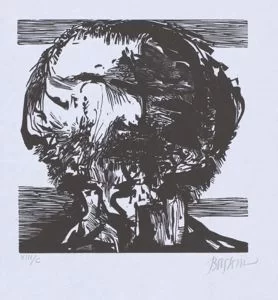Pictor Ignotus
In printmaker Leonard Baskin’s portfolio Laus Pictorum. Portraits of Nineteenth-Century Artists, he includes the Pictor Ignotus, or the Latin term used for “unknown artist.” While this may refer to poet and innovative printmaker William Blake (English, 1757-1827), it could also reference Robert Browning’s (English, 1812-1889) poem, or simply be a stand-in for the many artists we still do not know the names of.
The book Life of William Blake, “Pictor Ignotus.” was largely written by Alexander Gilchrist, who compiled materials and interviewed Blake’s surviving friends, and completed by artists Dante Gabriel Rossetti and William Michael Rossetti in 1863. The book became the first text on Blake. The phrase was taken from the 1845 poem by Browning, part of which was used as an epigraph for Blake’s biography, marking him as an obscure artist during his lifetime: “The sanctuary’s gloom at least shall ward / Vain tongues from where my pictures stand apart.” Browning’s poem is seen through the eyes of an older artist who is jealous for the fame of someone younger.
While Baskin may be directly alluding to these works, he might also be making a general statement for those skilled artists who remain unknown or obscure today through the silhouetted outline of a head full of abstracted lines, marks, and scratches.


